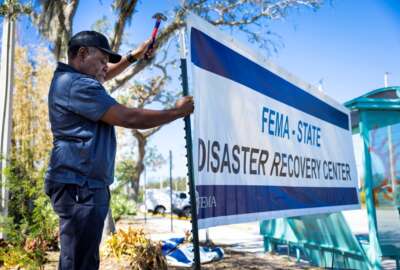The farther from agency headquarters, the harder the federal workforce challenges
In Hawaii, Alaska and U.S. territories, agencies are facing heightened challenges with hiring and retaining the federal workforce, GAO found in a recent report.
Recruiting and retaining the federal workforce is a common struggle for many agencies — but the farther removed employees are from agency headquarters, the more difficult the problems seem to get.
In Hawaii, Alaska and U.S. territories, agencies are seeing heightened challenges with hiring and retaining federal employees, the Government Accountability Office found in an Oct. 15 report.
For GAO, federal workforce challenges are pervasive and long-lasting. Strategic human capital management — or the ability for agencies to address mission-critical skills gaps — has remained on GAO’s high-risk list since 2001.
“Such issues are no different in Hawaii, Alaska or the U.S. territories,” Dawn Locke, GAO’s director of strategic issues, said in an interview with Federal News Network. “It’s the same there, but as you can imagine, these regions face a unique set of challenges.”
Those human capital challenges place a “great burden” on the existing federal workforce — and create rippling effects beyond that as well.
“It can have a huge impact on not just the existing employees and their increasing workload, but can also have an impact on customer service and the customer experience, such as longer wait times when visiting Social Security, or a decrease in national park services.”
Outside agency headquarters, field staff on the front lines typically report lower engagement and satisfaction, according to data from the Federal Employee Viewpoint Survey (FEVS). In an analysis of FEVS results, the Partnership for Public Service found that employee pay satisfaction at field offices is 8% lower than it is at agency headquarters. Field office employee scores are also almost 10% lower than headquarters on how satisfied they are with the recognition they get from their agencies.
“Investments in strong internal communication, connections between leaders and staff, robust growth opportunities and strategic mission integration help create an environment in which employees feel that many of their most important workplace needs are addressed,” the Partnership wrote earlier this year in a report on the frontline federal workforce.
Difficulties with federal workforce incentives
There are several options agencies can use to try to improve recruitment in geographic regions far from agency headquarters. If it’s determined that it would be particularly difficult to recruit, retain or relocate employees, agencies can turn to the Office of Personnel Management to try to get approval for additional pay incentives.
On paper, the incentives are meant to encourage employees in the federal workforce to go work in those hard-to-recruit areas, and stay there. But in practice, it’s often difficult for agencies to work out the logistics of how and when those incentives can actually be used, GAO found in its report. Federal HR staff often find the authorities too time-consuming or difficult to use, and receive inconsistent guidance on how to use them. There’s also some difficulty getting approval from OPM to use the incentives, GAO said.
Some agencies, however, are taking steps to try to close that knowledge gap. The National Park Service, as an example, has been working to try to offer more tailored support to its hiring managers, GAO said. Using a hiring manager satisfaction survey, NPS can pinpoint where there are issues and then try to provide support.
The Transportation Security Administration (TSA) also recently began offering expanded relocation incentives for any employees who sign a 12-month agreement to work at an airport where hiring is especially difficult.
But beyond just getting people to take positions in Alaska, Hawaii and U.S. territories, GAO also found that there are also limited opportunities for career growth when working in federal jobs outside the mainland U.S.
“There are plenty of entry-level careers and management careers in Hawaii, Alaska and the territories, but there’s no mid-level, so there’s no pipeline that gets you from entry-level to management,” Locke said. “If individuals in these entry-level careers want to rise in their fields, they have to leave and live in the mainland.”
And once those employees move back to the mainland to reach mid-level federal positions, Locke said often, they’ll stay there and not return to the take up senior roles in Alaska, Hawaii or U.S. territories.
Federal workforce challenges with cost of living
High costs of living, as well as the costs of relocating to regions outside the continental U.S., also create unique challenges for agencies trying to hire in Alaska, Hawaii and U.S. territories.
Housing, education, gas, groceries and other daily living expenses add up significantly. In some remote areas of Alaska, for instance, a gallon of milk can cost upwards of $12. On top of that, GAO found that the federal workforce in those regions sees limited availability of medical care and child care.
And in many cases, based on GAO’s research and conversations with agencies, federal employees’ salaries don’t effectively cover housing costs combined with other costs of living.
The costs of relocating can also be quite cumbersome. From conversations with agency officials, GAO found that moving costs to those areas can range anywhere from $10,000 up to $150,000.
All those cost-related factors, of course, “can be a deterrent that leaves people not wanting to take these posts,” Locke said.
In one effort to address cost and housing issues, Jason Nelson, chief human capital officer at TSA, recently told Federal News Network that the agency has been looking at options for offering airport staff access to alternative and more affordable housing — something that’s lacking in more remote airport locations such as Nome, Alaska, or the Northwestern Islands of Hawaii.
USAJobs difficulties deter federal job seekers
When it comes to the application process itself, GAO said many local applicants find USAJobs intimidating and federal job descriptions unclear. There are also cultural barriers between local communities in Alaska and Hawaii, and the federal application process, GAO found.
“For example, Native Hawaiian and Pacific Islander culture places great importance on humility, so individuals may shy away from labeling themselves as experts, if you will, in their respective fields, despite having the necessary qualifications,” Locke said.
Because of the way the federal recruitment process is set up, when candidates mark themselves lower on different qualifications for a job, they’re then much less likely to land a federal job.
Some agencies, such as the National Park Service and the Fish and Wildlife Service, however, are trying to address the disconnect by creating mentorship groups and conducting trainings for federal job seekers. TSA has also been hosting events to walk job seekers through the USAJobs application process.
“What’s really great about this is TSA employees help applicants build their USAJobs profile while they’re on site together,” Locke said. “The applicants can also take a computer-based test, schedule a medical appointment and sometimes have an interview all in one day when they’re on site with these TSA employees.”
Still, staff members have said despite the support, the time it takes to apply may deter candidates, and continue to make recruitment difficult, GAO found.
But if done well, recruiting from local populations can be a great benefit to these agencies, especially, for example, at the National Park Service.
“We heard repeatedly that successfully hiring these local candidates can often correlate to stronger retention because they’re already acclimated to the region, they’re embedded in the culture and are more likely to have family and friends nearby who serve as support networks,” Locke said. “They grew up learning about the land, the flora and the fauna, they grew up fishing in the ocean, so they’ve spent a lifetime accumulating the knowledge and skills that NPS needs.”
Disconnect between frontline staff, agency HQ
Frontline federal employees are both literally and figuratively more distant from headquarters, which can create a different type of challenge for the federal workforce.
The Partnership for Public Service, for instance, found in its research that field employees are sometimes away from internet access or aren’t checking their email for extended periods of time — leaving them to rely on conversations with colleagues to get information from headquarters.
“An overemphasis on colleagues as primary sources of information can result in a game of ‘telephone.’ In such situations, colleagues pass on the information they receive from a secondary source,” the Partnership wrote in its report. “By the time that information reaches front-line employees, only part of the primary message remains. In the worst cases, staff members miss critical information about professional development or employer benefits that they are entitled to know about.”
The distance also shows through in how the federal workforce views senior leaders. The Partnership’s data showed that field employees scored 52% on how effective they believe agency leadership is, while headquarters staff scored about 62% on the same topic.
“Quite frankly, a one-size-fits-all approach doesn’t work for these locations, and headquarters may not understand their unique challenges with recruitment and retention,” Locke said. “In turn, they may not offer enough support, or the right support, to help the staff really navigate this.”
Ultimately, GAO said leaders at agency headquarters should make sure there is clear, consistent guidance, two-way communications, training for employees — and better support when and where field offices need it. GAO also recommended that agencies collect feedback so that they can better understand the specific needs of any geographic region.
Locke said those efforts “would go a long way to help address the disconnects we found.”
Copyright © 2025 Federal News Network. All rights reserved. This website is not intended for users located within the European Economic Area.
Drew Friedman is a workforce, pay and benefits reporter for Federal News Network.
Follow @dfriedmanWFED






